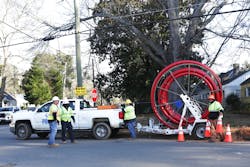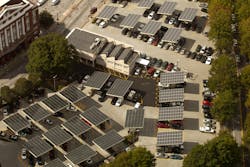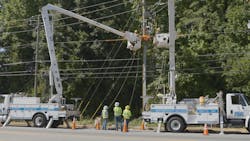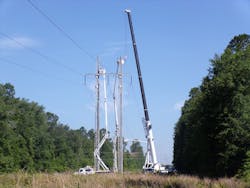Georgia Power Shares Grid Investment Plan
The utility is recognized by J.D. Power, the consumer data and rankings research firm, as an industry leader in customer satisfaction. In the past four years, a significant number of its customers have transitioned to working from home. Customers are more sensitive to residential outages, especially on blue-sky days. For this reason, Georgia Power has identified opportunities for strengthening the energy grid and improving the customer experience, which is the basis for its grid investment plan.
The Plan
In 2019, Georgia Power envisioned and proposed a massive energy grid investment project, winning approval from the Georgia Public Service Commission (PSC) to begin work in 2020. While customers see crews in the field maintaining the energy infrastructure every day, work under this plan goes beyond the day-to-day and addresses underperforming equipment and aging substations, while strengthening power lines to make the system more resilient.
Whether in blue skies or stormy weather, resiliency can help utilities to prevent outages and, when a service interruption does occur, restore power more quickly — although no system is weatherproof. In Georgia, the grid faces hurricanes, ice and snow, thunderstorms with strong winds and lightning, and typically more than 50 days per year with temperatures higher than 90°F (32°C).
Georgia Power’s grid investment plan is focused on upgrading transmission and distribution infrastructure across the energy grid to improve the system’s reliability and resiliency and decrease the number and length of power outages experienced by customers.
During the initial three-year phase of the plan, from 2020-2022, Georgia Power is investing US$1.3 billion in strategic upgrades to the energy grid, which will positively impact service for approximately 280,000 customers. To date, the project has included adding more than 280 miles (451 km) of new neighborhood power lines, installing over 830 smart devices on main power lines, rebuilding four substations, and installing or replacing over 13,000 power poles that no longer met the utility’s standards.
The plan began geographically around the eastern and southern parts of metro Atlanta, Georgia, as well as the northwest corner of the state, where the utility identified power lines that needed improvement. The plan is strategic and efficient, with project locations selected based on historical service and performance data. Georgia Power has been deliberate about these investments, analyzing performance data and trends to ensure it is putting its resources in the right places and leveraging technology to move the needle on reliability.
Strategic Investments
According to the U.S. Census Bureau, in 2020, Georgia ranked among the top five states for growing population in the last decade. World Population Review lists it as the second fastest growing state in the U.S. in 2022. This growth puts more demand on the energy grid. Between more and more people plugging in multiple electronic devices, working from home and driving electric vehicles, demand for reliable electric
service is expected to grow.
Georgia Power has been evaluating the energy grid carefully and analyzing power line circuits to deploy customized solutions that will improve reliability and resiliency. The plan strategically targets underperforming distribution power lines and aging transmission assets. These investments not only benefit customers but also support efforts to transition to a fleet with a net-zero carbon footprint by 2050.
In its first phase, the utility has deployed various customized solutions to help make the grid more resilient, reduce service interruptions and shorten outage times. Some of the solutions have included deploying smart technology throughout the grid; improving substations and, in some cases, rebuilding facilities; strengthening main circuits and neighborhood power lines; adding more neighborhood connections; and, where it makes sense, relocating lines underground.
Install Smart Technology
As part of its grid investment plan, Georgia Power is installing smart technology that helps to prevent power outages and, when interruptions do occur, service can be restored faster. Without automated line equipment, like electronic reclosers and programmable fusing devices, a problem on the line can cause all customers served by the line to lose power. By adding smart, automated line devices, outages are automatically isolated to smaller portions of the line, so that fewer customers lose service when an issue occurs.
Improve Substations
Substation investments can have a lasting, positive impact on a growing community. Georgia Power is working on rebuilding and improving its substations. Substations carry high-voltage energy, which is then stepped down safely to meet the needs of homes and businesses in the surrounding neighborhoods. By rebuilding some substations, replacing underperforming equipment and adding neighborhood power lines, the utility is creating redundancies between substations and providing greater reliability for customers.
Strengthening Overhead, Underground
After reviewing transmission line performance data from around the state, the utility targeted those most in need of work. Based on their condition, overhead lines and structures are being replaced as well as transmission elements nearing their life cycles according to industry standards.
Some of the work involves burying neighborhood power lines, which makes them far less vulnerable to falling trees, high winds and other adverse weather conditions. By placing these lines underground, where it makes sense, the utility can reduce outages on overhead lines. Burying power lines can help to create a more resilient energy grid because it makes the lines less vulnerable. It also creates a safer environment for utility crews.
For every overhead outage reduced, that is one less truck roll employees have to make and one less time they are put in an emergency response situation. Undergrounding, however, is not a fault-proof solution. In areas prone to flooding, underground root systems or wildlife, and hazards from digging or other disruptions, burying lines is not a good option. Also, when an issue does occur underground, it can be harder and more disruptive to restore service.
Power Line Connections
Georgia Power also is improving neighborhood power poles and lines, replacing those that no longer meet its standards. The utility is adding line connections and relocating power lines to front easements, to make it easier for repair crews to access the line in the event of an outage and restore power more quickly. It also is improving basic insulation levels to further protect equipment.
First-Phase Results
With its grid investment plan, Georgia Power is building an energy future for its customers, investing in the grid to make it more resilient. These improvements are enabling the grid to better withstand conditions like extreme temperatures, high winds, storms and other difficult conditions.
The plan is about making smart investments that advance the utility’s commitment to delivering the safe, clean, affordable and reliable energy customers expect and deserve — and the plan is working. Grid improvements from the first phase of the utility’s investment plan are showing results of up to 40% improvement in reliability for many customers, meaning 40% fewer outages and, when service is interrupted, faster restoration times.
Editor’s note: An interactive map of improvements can be found at GeorgiaPower.com/Grid. Enter an address to see where crews are working on grid investment projects to make the energy grid more resilient.
Fran Forehand serves as senior vice president of power delivery for Georgia Power. In this role, she is responsible for safety and health and the planning, design, operations, construction and maintenance of Georgia Power’s distribution and transmission systems. Under her leadership, the power delivery organization reliably serves 2.7 million customers in 155 counties across Georgia with a grid of more than 77,000 miles (123,919 km) of distribution lines and over 12,000 miles (19,312 km) of transmission lines. She also serves on the utility’s management council.
About the Author
Fran Forehand
Fran Forehand serves as senior vice president of power delivery for Georgia Power. In this role, she is responsible for safety and health and the planning, design, operations, construction and maintenance of Georgia Power’s distribution and transmission systems. Under her leadership, the power delivery organization reliably serves 2.7 million customers in 155 counties across Georgia with a grid of more than 77,000 miles (123,919 km) of distribution lines and over 12,000 miles (19,312 km) of transmission lines. She also serves on the utility’s management council.




